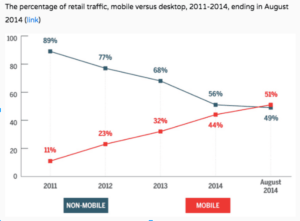It wasn’t too long ago that store owners were asking if they really needed a website. After all, they already had a big sign in front of their shop, so how was a website going to help them?
Of course, we all know now that having a web presence for your business isn’t an option, it’s a necessity. So the new argument goes a little something like this:
“Do I really need an app? I already have a website.”
Times change, and if you don’t adapt you’ll fall behind. In the world of ecommerce, falling behind typically leads to going out of business. A shop selling similar products will come along with an engaging mobile app that blows your web experience out of the water.
Back in 2014, mobile retail traffic surpassed desktop retail traffic, according to Digital Commerce 360.

Last year, an eMarketer forecast predicted mobile ecommerce sales would exceed $123 billion in 2016, up 39 percent from 2015, meaning mobile ecommerce would make up about one third of the total ecommerce market. On top of that, Business Insider Intelligence predicts mobile ecommerce will make up 45 percent of a $600 billion ecommerce market by 2020.
We’ve entered the mobile era, and choosing to ignore that will leave you looking like those businesses that ignored the dot-com revolution just a few years ago.
What will a mobile app do for me and my store?
Of course, the industry isn’t just changing for the sake of it. A mobile app has massive growth potential for your business. When customers shop via your app, you will have much greater control over their experience than when they shop on your website.
Instead of hoping they land on your website and see your banner ad or pop-up box advertising a generic sale, you can send push notifications about specific product sales based on each customer’s past purchases. Since you control the playing field, you get to maximize your sales potential.
Isn’t a mobile-optimized website enough?
A mobile-optimized website is a must, even if you do have an app. Still, relying on a website alone restricts your marketing potential when a visitor doesn’t make a purchase the first time around.
If a potential customer does buy something from you, you can use targeted email marketing to upsell them on something else. That’s the ideal scenario. Customer lands on the page, buys something, then buys even more down the road thanks to your targeted ads and offers.
Unfortunately, more often than not, your web traffic doesn’t convert the first time around. Now you’re left starting from scratch if the customer happens to land on your website again.
Sure, you can cookie visitors and retarget them with banner ads and Facebook ads, but retargeting is starting to face some resistance. This summer, Apple announced that Safari will have a new feature that limits the use of cookies for ad retargeting to just 24 hours after a potential customer leaves a page, meaning you only get one day to hit them with targeted ads.
What’s a more sustainable solution?
Building a mobile app.
An app gives you control over how someone experiences your store. No more relying on third-party browsers to help you make sales and build up your customer list.
Beyond the retargeting potential, a mobile app is the perfect platform for a loyalty program. When someone makes a purchase, they get some sort of loyalty bonus that encourages them to come back.
Take a look at Starbucks’ loyalty program. When you order a drink, you get stars. Once you have enough stars, you can redeem them for a free drink. They do let you access the loyalty program through their website, but their mobile app has been the main driver for its success.
Currently, around 41% of all Starbucks transactions are made through their loyalty cards, and 24% of those transactions happen through their mobile app. Without the mobile app, sales would plummet. They’ve utilized mobile-focused programs like Mobile Order & Pay, which lets customers place an order ahead of time so they can skip the line when they’re in a rush, to maximize their mobile app loyalty potential.
Customer loyalty and repeat purchases, all thanks to your app.
So when is the right time to build an app?
At this point, you’re sold on the why, and now the question is when. When should you get the ball rolling and start building an app for your ecommerce store?
1. When you have the resources to create it
Unless you’re 100 percent certain the app you build will play a pivotal role in growing your ecommerce business a new revenue stream, don’t go into massive debt to build an app. Keep spending time on your existing customer base and growing the existing online platform to attract the right customers. Once you have the resources, it’s time to establish a business case, then when you’re ready to launch and have the resources in hand to bring on the right, invest in a mobile app.
The costs will depend on whether you choose to outsource the creation of your app or build it in-house. We’ve put together a great guide to help you navigate that crucial decision—you can grab it right here for free.
2. When the majority of your traffic is coming from mobile
If you’re starting to see most of your web traffic coming from mobile, it’s time to invest in a mobile app. Your customers are telling you they prefer to shop your store from their phones, which should make launching an app that much easier.
Why? You won’t be faced with as much resistance from customers and potential customers as you would if they were used to desktop shopping. They already shop from their phones; all you’re doing is making that experience richer and even more intuitive.
If you’re getting mobile traffic and not capitalizing on it long term with push notifications and targeted sales, you’re leaving money on the table.
3. When you decide you don’t want to get left behind
Plain and simple: your competitors are already building apps of their own.
If you decide to wait and wait and wait until a mobile app is a MUST, you’ll already be so far behind that it’ll be near impossible to catch up.
Think back to the website debate again. The businesses that created websites early on and gave their customers a new avenue to buy set themselves up for success much more than the businesses that kept it traditional.
A perfect example is Sears Canada. They’re notorious for being slow to adapt to changes in the market. Because of that, they’ve just announced that they’re going out of business entirely. While there are certainly more factors involved than just slowness to adapt, once the typical shopping experience was moved online thanks to the likes of Amazon, Sears continued to focus their efforts on the in-person, in-store sales process. Clearly it didn’t work out the way they hoped.
Wrapping things up
Mobile ecommerce is on the rise. If you decide to ignore that, you’re going to fall behind.
In 2016, a comScore survey found that shoppers made 51 percent of their purchases online, up from 48 percent in 2015. On top of that, 44 percent of smartphone users made a purchase from their device. The Wall Street Journal predicts that around 190 million U.S. consumers will shop online this year.
Online shopping fears are a thing of the past. Consumers are comfortable purchasing online, and they’re becoming far more comfortable purchasing from their mobile devices.
The time to start thinking about a mobile app for your ecommerce store is now. If you think you’re ready to get started, get in touch with us today. We’ll help you bring your mobile app dream to life.



